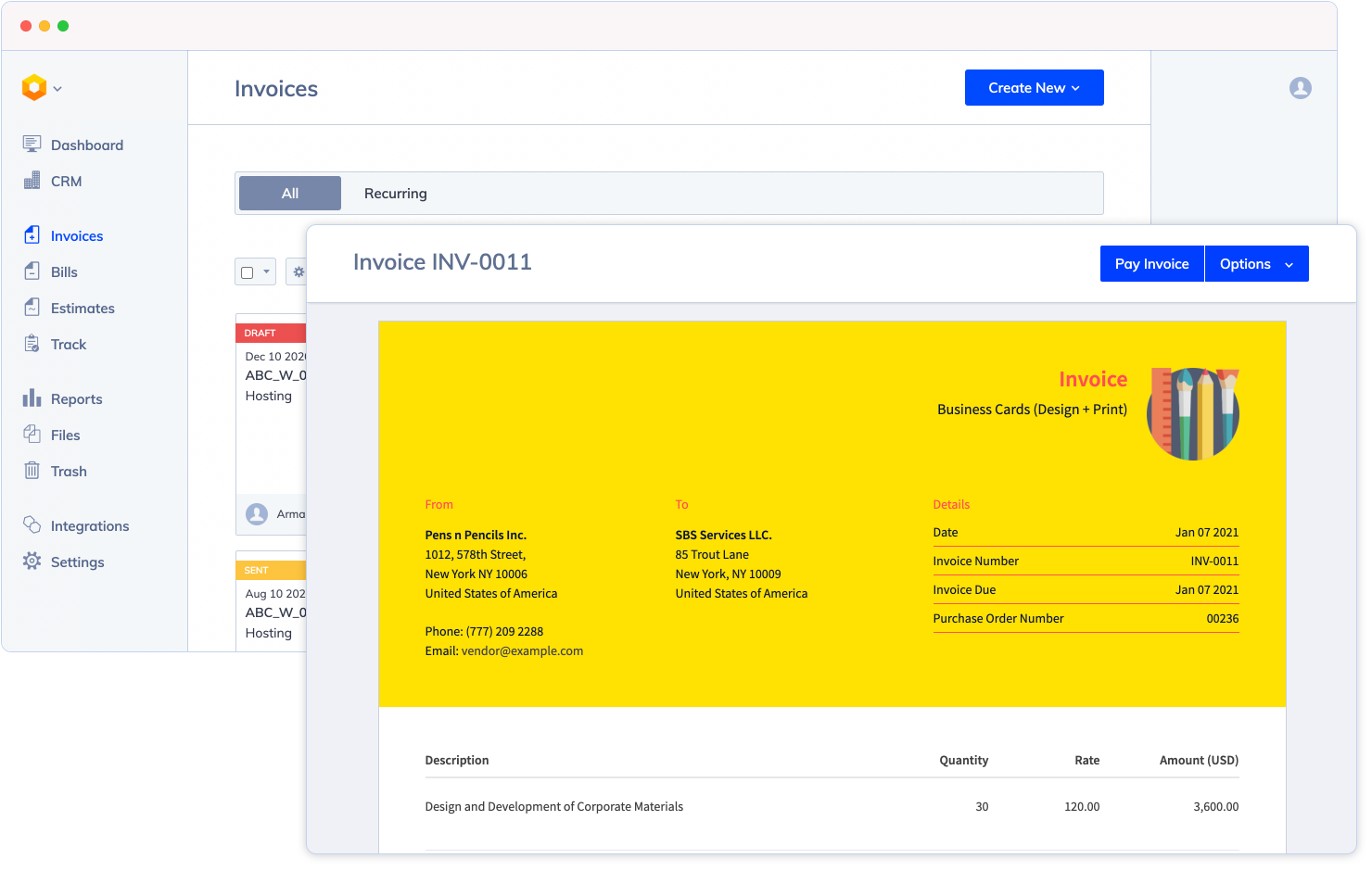Invoice Tracking Made Easy with Hiveage's A Complete Guide
Every small business owner soon comes to realize that managing financial processes efficiently is crucial for success. In a previous article on invoice reconciliation, we discussed how our own entrepreneurial journey had some hard lessons for us in this regard. You can’t over emphasize the importance of maintaining accuracy and efficiency in your financial operations, no matter the size of your business.

Building on that foundation, another key component we should pay attention to is invoice tracking, a process that ensures not just the accuracy of transactions, but also their timely management and execution. Effective invoice tracking is essential for maintaining robust cash flow management, preventing delays in payments, and securing the financial health of your business.
Invoice tracking goes beyond merely knowing what payments are due; it involves a systematic approach to monitoring every invoice from creation to closure. This process helps SMEs stay organized, ensures timely payments, and supports stronger vendor and customer relationships. However, without a proper system in place, tracking invoices can become a cumbersome task prone to errors and inefficiencies, which can impede a business’s growth and financial stability.
In this article, we will explore the best ways to track invoices. We’ll discuss essential features of an effective invoice tracking system, guide you on selecting the right tools, and discuss strategies to implement these systems seamlessly into your business operations. By the end of this guide, you’ll be equipped with the knowledge to enhance your invoice tracking practices, thereby ensuring your business remains organized and financially sound.
Understanding Invoice Tracking
Invoice tracking is a critical component of financial management for any small business. It involves monitoring the status of every invoice throughout its lifecycle—from issuance to payment. This process not only helps ensure that invoices are paid on time but also plays a significant role in maintaining healthy cash flow and financial transparency.

Significance of Invoice Tracking for SMEs
For SMEs, effective invoice tracking can mean the difference between a smoothly running operation and one plagued by cash flow issues. Timely tracking helps prevent the accumulation of unpaid invoices, which can seriously impact your operational budget and financial planning. Additionally, it allows for better financial forecasting and resource allocation, ensuring that funds are available when needed for business growth and investment.
Connection Between Invoice Tracking and Cash Flow
The immediate benefit of diligent invoice tracking is improved cash flow management. By keeping a close eye on when invoices are due, you can better manage incoming and outgoing payments. This synchronization of cash inflows with outflows helps avoid the pitfalls of cash shortages, ensuring that your business can meet its financial obligations on time, every time.
Common Pitfalls in Invoice Management
Despite its importance, many SMEs encounter challenges with invoice tracking due to a few common pitfalls:
- Disorganization: Without a structured system, invoices can easily get lost or forgotten, leading to delayed payments and financial discrepancies.
- Manual Processes: Relying on manual methods for tracking invoices is time-consuming and prone to human error. This can lead to incorrect billing, missed payment deadlines, and an overall inefficient invoice management system.
- Lack of Visibility: In some cases, invoices are managed across multiple departments or even locations, making it difficult to maintain visibility over the entire process. This lack of oversight can result in inconsistent record-keeping and difficulty in reconciling invoices with payments.
Addressing these pitfalls is crucial for enhancing the efficiency and accuracy of your invoice tracking system. In the following sections, we will explore essential features of an effective invoice tracking system, offer advice on selecting the right tools, and discuss how to implement these solutions to optimize your invoice management process. By understanding and addressing these common challenges, you can set a solid foundation for financial health and operational success.
Essential Features of an Effective Invoice Tracking System
For small businesses looking to enhance their invoice tracking processes, selecting a system with the right features is crucial. These features not only streamline operations but also mitigate the risks of errors and inefficiencies. Here, we explore the key functionalities that your invoice tracking system should possess to maximize effectiveness and support your business’s financial management.

Automation
Automation stands at the forefront of efficient invoice tracking. An effective system should be able to automate routine tasks such as generating invoices, sending reminders, and updating payment statuses. This reduces the manual workload on your team and minimizes the risk of human errors, such as forgetting to send an invoice (which happens more often than you’d expect!) or failing to record a payment.
Real-Time Updates
A system that provides real-time updates ensures that you have the most current information at your fingertips. This feature is essential for maintaining an accurate view of your cash flow at any given moment. It allows for quick adjustments in your financial planning and ensures that you can respond promptly to any issues that may arise, such as overdue invoices or unexpected expenses.
Integration Capabilities
The best invoice tracking systems offer robust integration with other business tools such as accounting software, CRM systems, and banking apps. This connectivity ensures that data flows seamlessly between systems, reducing the need for manual data entry and the potential for errors that it brings. Integration also provides a more holistic view of your finances, helping you make informed decisions based on comprehensive data.
User-Friendly Interface
Ease of use is another critical feature for any invoice tracking system. A user-friendly interface ensures that all team members, regardless of their technical skills, can effectively use the system. This accessibility is crucial for ensuring that the system is adopted throughout your organization, maximizing its benefits and ensuring that everyone is on the same page.
Scalability
As your business grows, so too will your invoicing needs. A scalable invoice tracking system can grow with your business, accommodating more clients, invoices, and data without performance degradation. This means you won’t need to switch systems as your business expands, providing continuity and stability in your invoice management practices.
Security
Given the sensitive nature of financial data, security is non-negotiable. Your invoice tracking system should have strong security measures in place, such as data encryption, secure user authentication, and regular backups. These features protect your data from unauthorized access and potential data loss, ensuring that your financial information remains confidential and intact.
Customization
Finally, the ability to customize the system to fit your specific business needs is a significant advantage. Whether it’s custom invoicing templates, specialized reporting, or specific reminder settings, a customizable system can adapt to your unique operational requirements and help streamline your processes even further.
Selecting an invoice tracking system with these essential features will not only improve the efficiency of your invoicing process but also enhance your overall financial management, making it easier to maintain a healthy cash flow and support your business’s growth. In the next section, we will delve into how to choose the right invoice tracking tool that best fits your business needs and objectives.
Choosing the Right Invoice Tracking Tool
Selecting the appropriate invoice tracking tool is critical for optimizing your business’s financial operations. As you evaluate different options, it’s essential to consider several key factors that align with your business needs and goals. For SMEs using or considering Hiveage, understanding how it fits into this selection process can help you make an informed decision. Here's a guide on what to look for and how Hiveage might serve as the solution you need.
Assessing Your Business Needs
Before diving into the features of various tools, take a step back and assess your business's specific needs. Consider the volume of invoices you manage, the complexity of your billing processes, and the integration needs with other systems. This assessment will help you determine which features are most crucial for your operations.
Key Criteria for Selection
- Functionality: Does the tool offer all the essential features mentioned earlier, such as automation, real-time updates, and security? Ensure the tool you choose can handle your invoicing workflow from start to finish.
- Ease of Use: The best tool is one that you and your team can use efficiently. User-friendly interfaces reduce training time and make it easier for your team to adopt new software.
- Integration: Consider how well the tool integrates with other software you use. This can include everything from accounting packages to CRM systems. Seamless integration can significantly reduce administrative overhead and ensure accuracy.
- Cost: Cost is always a consideration, especially for SMEs. Evaluate the pricing structures of different tools to find one that offers the best value based on the features it provides.
- Support and Reliability: Look for a tool that offers reliable customer support. Good support can drastically reduce downtime and improve user satisfaction.
- Scalability: Make sure the tool can scale with your business. It should be able to accommodate growth in terms of more clients, more invoices, and more complex data management needs without requiring a system overhaul.
How Hiveage Fits Your Needs

Hiveage, designed with the needs of SMEs in mind, excels in several key areas:
- Automation and Ease of Use: Hiveage automates numerous invoicing tasks and boasts a straightforward, intuitive interface that makes invoice tracking effortless.
- Integration: It offers robust integration capabilities with a wide variety of payment gateways and business software, facilitating a cohesive flow of data across your financial systems.
- Cost-Effectiveness: Hiveage provides a scalable pricing model that allows you to choose a plan that best suits your business size and budget, ensuring you only pay for what you need.
- Reliable Support: With a dedicated support team, Hiveage ensures that any queries or issues are promptly addressed, minimizing potential disruptions to your business operations.
Evaluating the Tool
Once you’ve identified your needs and reviewed the features and benefits of Hiveage, consider signing up for a trial period. This allows you to test the software in real-world scenarios to see if it meets your expectations and fits seamlessly into your operations.
Choosing the right invoice tracking tool is a strategic decision that can significantly affect your business's efficiency and financial health. By carefully considering your needs and the capabilities of tools like Hiveage, you can ensure that your business is equipped with the best resources to manage its invoicing effectively and grow sustainably.
Implementing an Invoice Tracking System
Successfully implementing an invoice tracking system in your business is a crucial step towards enhancing your operational efficiency and financial oversight. This process involves more than just selecting the right tool; it requires careful planning, training, and adoption across your organization. Here’s a step-by-step guide to help you integrate an invoice tracking system like Hiveage effectively.
Preparation and Planning
- Define Objectives: Clearly define what you want to achieve with the new invoice tracking system. Whether it’s reducing the time it takes to process invoices, improving cash flow management, or enhancing data accuracy, having clear goals will guide the implementation process.
- Involve Key Stakeholders: Engage with key stakeholders from various departments (such as accounting, sales, and IT) to gather input and ensure the system meets everyone’s needs. Their early involvement can also help in addressing any concerns and fostering support for the change.
- Data Migration Plan: Plan for the migration of existing data to the new system. This might include historical invoice data, customer details, and payment records. Ensure the data is clean and organized before migration to avoid complications.
System Configuration and Integration
- Customization: Customize the new system to fit your business processes. This might involve setting up invoice templates, payment terms, and integration with other business systems like your CRM or accounting software.
- Test Integrations: Thoroughly test the integration points with other systems to ensure that data flows smoothly and accurately between them. This step is crucial to prevent data silos and ensure cohesive operations.
Training and Support
- Training Sessions: Conduct comprehensive training sessions for all users of the invoice tracking system. Ensure that everyone understands how to use the features relevant to their role. Adequate training reduces resistance to new software and helps in smooth adoption.
- Provide Resources: Create resource materials such as user manuals, FAQ documents, and how-to videos. These resources can help users feel more confident in using the new system.
- Establish Support Channels: Set up internal and external support channels to assist users with any issues that might arise. Having readily available support can alleviate frustrations and prevent disruptions in invoice processing.
Rollout and Evaluation
- Soft Launch: Consider a phased rollout where you start with a smaller group of users or a particular department. This approach allows you to gather feedback and make adjustments before a full-scale implementation.
- Gather Feedback: After the rollout, actively seek user feedback to understand how well the system is meeting business needs and where improvements are needed. This feedback is invaluable for refining the system and enhancing user satisfaction.
- Continuous Improvement: Treat the implementation as an ongoing process. Continuously assess the system’s performance and make necessary adjustments. Regular updates and improvements will help keep the system aligned with your business’s evolving needs.
By following these steps, you can ensure a smooth transition to a new invoice tracking system like Hiveage. This not only minimizes disruptions to your business operations but also maximizes the benefits of the system, helping you achieve greater efficiency and better financial control.
Overcoming Challenges with Invoice Tracking
Implementing a new invoice tracking system like Hiveage can present a range of challenges, from technical issues to resistance from staff. However, with proactive planning and the right strategies, these obstacles can be effectively managed and overcome. Here’s a guide to identifying common challenges in invoice tracking and deploying solutions that ensure successful system adoption and functionality.

Common Issues in Invoice Tracking
- Data Discrepancies: Errors can creep into your system when migrating data from old systems or integrating multiple sources. These discrepancies can lead to inaccurate invoicing or payment mismatches.
- User Adoption Hurdles: Resistance to change is a common human behavior. Some team members may be reluctant to switch from a familiar system to a new one, particularly if they perceive it as more complex or unnecessary.
- Technical Glitches: No system is immune to technical issues, especially in the early stages of implementation. These can range from simple bugs to major integration problems with existing software.
- Training Gaps: Inadequate training can lead to improper use of the invoice tracking system, which in turn can cause inefficiencies and errors in the invoicing process.
Strategies to Overcome These Challenges
- Thorough Data Audit and Cleanup: Before migrating to a new system like Hiveage, conduct a thorough audit of your existing data. Cleanse any outdated or incorrect data to ensure that only accurate and relevant information is transferred. This helps minimize discrepancies post-migration.
- Engaging Training Programs: Develop engaging and comprehensive training programs that cater to different learning styles. Include hands-on sessions where users can practice tasks they will perform daily. This makes the learning experience more relevant and less daunting.
- Gradual Implementation: Instead of a full-scale immediate implementation, consider a phased approach. Start with one department or a small group of users, work out any issues, and then gradually expand to other parts of the organization. This allows you to manage resistance and adjust processes in manageable segments.
- Regular Feedback Loops: Establish mechanisms for regular feedback from users at all levels. This can help you quickly identify and address concerns about the new system, making adjustments where necessary to improve user experience and system performance.
- Robust Technical Support: Ensure that robust technical support is available both during and after the implementation. Quick access to support can alleviate user frustration and help resolve technical issues swiftly, ensuring minimal disruption to daily operations.
- Continuous Improvement and Updates: Treat the implementation of your invoice tracking system as an ongoing project. Regular updates and refinements based on user feedback and evolving business needs can help keep the system effective and relevant.
By anticipating these challenges and preparing strategies to address them, you can ensure a smoother transition to the new invoice tracking system. This proactive approach not only enhances the adoption and effectiveness of the system but also supports the long-term success of your financial operations.
Leveraging Invoice Tracking for Business Growth
Effective invoice tracking is not just about managing bills and payments—it can also be a strategic tool that supports broader business objectives. By optimizing your invoice tracking processes, you can enhance customer and supplier relationships, gain valuable insights for strategic decision-making, and position your business for growth. Here’s how to leverage your invoice tracking system, like Hiveage, to contribute to your business’s expansion and success.

Enhancing Supplier and Customer Relationships
- Timely Payments: Consistent and timely payments, facilitated by effective invoice tracking, help build trust with your suppliers and customers. This reliability can lead to better negotiation terms and stronger partnerships.
- Clear Communication: An efficient invoice tracking system allows for clearer communication regarding billing and payments. You can promptly address any inquiries or issues, which improves satisfaction and loyalty among your clients and suppliers.
Data-Driven Decision Making
- Financial Insights: Invoice tracking systems provide a wealth of data about your business transactions. By analyzing patterns in this data, you can identify trends such as seasonal demands, customer payment behaviors, and supplier reliability. These insights allow for more informed financial planning and resource allocation.
- Budget Optimization: With detailed tracking, you can more accurately forecast cash flow and adjust budgets accordingly. This helps in minimizing wastage and optimizing expenditure, which is crucial for maintaining financial health and funding growth initiatives.
Future Trends and Technology Adoption
- Emerging Technologies: Stay informed about emerging technologies in invoice tracking and financial management. Technologies like AI and machine learning can automate more complex aspects of invoice management, such as predictive analytics for cash flow forecasting or automated discrepancy detection.
- Integration with Other Business Systems: Ensure that your invoice tracking system integrates seamlessly with other business systems like ERP, CRM, and analytics tools. This integration can provide a holistic view of your business operations, making it easier to identify areas for improvement and innovation.
Scalability and Adaptation
- Scalable Solutions: As your business grows, your invoice tracking needs will evolve. Choose a system like Hiveage that can scale with your business, accommodating an increasing number of transactions without a loss in performance.
- Adapting to Business Needs: Regularly review and adapt your invoice tracking practices to align with current business needs and goals. As your business landscape changes, your processes should evolve to support new business models or market expansions.
By leveraging your invoice tracking system strategically, you can not only streamline financial processes but also gain critical insights and foster relationships that propel your business forward. Effective invoice management thus becomes a cornerstone of strategic planning and business growth, helping you make more informed decisions and better prepare for future challenges and opportunities.
Conclusion
Effective invoice tracking is a cornerstone of robust financial management and plays a critical role in the stability and growth of your business. By implementing a comprehensive system like Hiveage, you not only streamline your invoicing processes but also enhance your ability to manage cash flows, maintain healthy supplier and customer relationships, and make informed strategic decisions.
Optimizing your invoice tracking does not end with the selection of a tool; it requires continuous effort in training, adaptation, and strategic use of the data you collect. Embracing this process can transform how you manage your finances, leading to greater operational efficiency and business success.
Are you ready to take control of your invoicing processes and drive your business growth? Start by evaluating your current invoice tracking system and consider how integrating a solution like Hiveage could improve your operations. Explore our features or sign up for a free trial today to unlock the full potential of your financial operations!
Join thousands of business-savvy entrepreneurs on our mailing list.
Curated emails that’ll help you manage your finances better.




